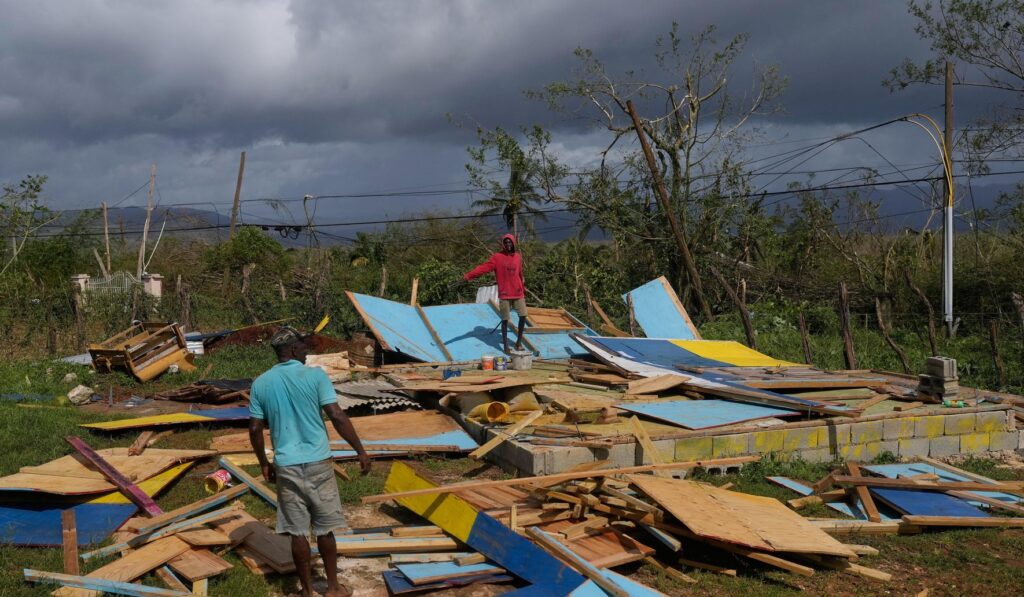Hurricane Melissa left dozens dead and widespread destruction across Cuba, Haiti and Jamaica, where roofless homes, toppled utility poles and water-logged furniture dominated the landscape Wednesday. The storm’s passage ripped through neighborhoods and exposed weak points in coastal and urban infrastructure, leaving residents to pick through the wreckage and start planning next steps.
In many communities, entire roofs were torn away, exposing bedrooms and living spaces to the elements. Furniture and personal belongings piled up in streets and yards, soaked and ruined, a visual measure of the suddenness and force of the storm. Photographs and on-the-ground accounts show neighborhoods that only hours earlier were full of life now scattered with debris and snapped trees.
Utility poles lay where they had stood for years, snapped or leaning after being struck by wind and falling branches. That damage plunged neighborhoods into darkness and made communications and coordination harder just when they were most needed. Without reliable electricity, pumps, medical equipment and refrigeration for food and medicine face immediate strain.
Flooding moved quickly into low-lying areas, leaving soaked floors and contaminated water behind. Water-logged furniture and appliances create long-term sanitation problems and complicate clean-up efforts. Standing water also raises the risk of mold and other hazards that can linger well after the skies clear.
Roads were littered with debris, slowing emergency crews and volunteers trying to reach battered neighborhoods. Blocked streets delay aid and push residents to improvise with boats, trucks or on-foot trips to safer ground. Clearing routes is the first practical step toward restoring basic services and moving emergency supplies where they are most needed.
People on the ground described a surreal mix of normal domestic scenes and total disruption: living rooms exposed to wind, kitchenware scattered on sidewalks, children’s toys half-buried in mud. That contrast underlines how quickly daily life can be overturned in a major storm and how personal recovery begins with small, basic tasks. Salvaging what can be saved becomes a priority for many households when safety allows.
Local shelters and community centers became temporary hubs for those who lost homes or could not safely return. In the hours after the storm, neighbors and local groups often formed the first response, sharing food, shelter and information. Those grassroots efforts are essential while larger relief organizations and government teams organize larger-scale support.
Electric crews and volunteers face a long, dangerous job undoing the worst of the damage to power lines and poles. Restoring electricity is not just a comfort issue; it’s a vital step for hospitals, water treatment facilities and communications. Repair work will take time, and many areas should prepare for intermittent service as repairs proceed.
Health risks grow in the wake of widespread flooding and standing water, with sanitation and access to clean drinking water becoming immediate concerns. Mold and mildew can affect homes left damp, and damaged plumbing complicates hygiene. Addressing these issues quickly reduces the chance of a secondary public health crisis.
Insurance and rebuilding will follow the emergency phase, but for many families the immediate hurdle is securing safe housing and replacing essential items. The scale of damage to roofs, utilities and personal belongings means recovery will be slow and often costly. Local economies tied to tourism and small business face additional strain as they work to reopen and recover customers.
Volunteers, community leaders and first responders are the backbone of the initial recovery push, coordinating makeshift shelters, sharing resources and documenting damage to prioritize help. Accurate assessments of destroyed homes, downed poles and flooded areas will guide the next steps in repairs and aid distribution. For residents, the focus now is on safety and small, practical steps toward getting back to daily life.



